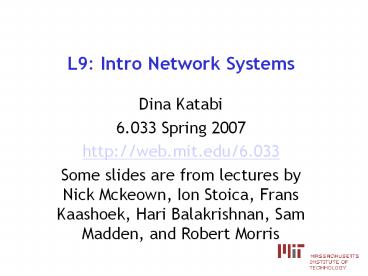L9: Intro Network Systems - PowerPoint PPT Presentation
Title:
L9: Intro Network Systems
Description:
... Switch Isochronous Multiplexing/Demultiplexing A time ... challenges Slide 6 Circuit Switching Isochronous Multiplexing/Demultiplexing Circuit ... – PowerPoint PPT presentation
Number of Views:84
Avg rating:3.0/5.0
Title: L9: Intro Network Systems
1
L9 Intro Network Systems
- Dina Katabi
- 6.033 Spring 2007
- http//web.mit.edu/6.033
- Some slides are from lectures by Nick Mckeown,
Ion Stoica, Frans Kaashoek, Hari Balakrishnan,
Sam Madden, and Robert Morris
2
What have you seen so far?
Systems Complexity Modularity Dtechnology/dt Hierarchy Therac-25
Naming systems Gluing systems File system name space
Client/service design Enforced modularity X windows
Operating systems Client/service with in a computer Eraser and Unix
Performance Coping with bottlenecks MapReduce
3
Client/service using network
server
request
OS
OS
network
- Sharing irrespective of geography
- Strong modularity through geographic separation
4
Network is a system too!
domain-1
domain-3
domain-2
- Network consists of many networks, many links,
many switches - Internet is a case study of successful network
system
5
Todays topic challenges
- Economical
- Universality
- Topology, Sharing, Utilization
- Organizational
- Routing, Addressing, Packets, Delay
- Best-effort contract
- Physical
- Errors, speed of light, wide-range of parameters
6
(No Transcript)
7
Circuit Switching
- Its the method used by the telephone network
- A call has three phases
- Establish circuit from end-to-end (dialing),
- Communicate,
- Close circuit (tear down).
- If circuit not available busy signal
Boston Switch
LA Switch
Caller
Callee
processing delay at switch
propagation delay between caller and and
Boston switch
DATA
(1)
(2)
(3)
8
Isochronous Multiplexing/Demultiplexing
Switch
interval
0
1
2
3
4
5
0
1
2
3
4
5
frames
- One way for sharing a link is TDM
- A time interval is divided into n frames
- Each frame carries the data of a particular
conversation - E.g., frame 0 belongs to the red conversation
9
Circuit Switching
- Assume link capacity is C bits/sec
- Each communication requires R bits/sec
- frames C/R
- Maximum number of concurrent communications is
C/R - What happens if we have more than C/R
communications? - What happens if the a communication sends
less/more than R bits/sec? - ? Design is unsuitable for bursty communications
10
Packet Switching
- Used in the Internet
- Data is sent in Packets (header contains control
info, e.g., source and destination addresses) - Per-packet routing
- At each node the entire packet is received,
buffered, and then forwarded) - No capacity is allocated
propagation delay between Host 1 Node 2
Header
Data
transmission time of Packet 1 at Host 1
processing delay of Packet 1 at Node 2
11
Asynchronous Multiplexing/Demultiplexing
Switch
Queue
- Multiplex using a queue
- Switch need memory/buffer
- Demultiplex using information in packet header
- Header has destination
- Switch has a forwarding table that contains
information about which link to use to reach a
destination
12
Aggregate Internet Traffic Smooths
- 5-min average traffic rate at an MIT-CSAIL router
Max In12.2Mb/s Avg. In 2.5Mb/s Max Out
12.8Mb/s Avg. Out 3.4 Mb/s
13
Statistical multiplexing
14
Best Effort
- No Guarantees
- Variable Delay (jitter)
- Variable rate
- Packet loss
- Duplicates
- Reordering
15
Networks are heterogeneous
Bits/s
Link technology
16
d(technology)/dt for networks
1,000,000
100,000
10,000
Normalized Growth since 1980
1,000
Moores Law 2x / 18 months
100
10
1
1980
1983
1986
1989
1992
1995
1998
2001
Thanks to Nick Mckeown _at_ Stanford for some of
these data points
17
Plan for studying network systems
Sharing and challenges 7.A Ethernet
Layering 7.BC End-to-end
Routing 7.D Internet routing
End-to-end reliability 7.E Network file system
Congestion control 7.F NATs































